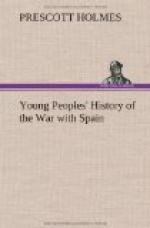[Illustration: Searching for Contraband.]
When the cargo was all ashore, the Florida prepared to return to the United States. Then the Cuban soldiers ranged themselves along the shore; women and children grouped behind the ranks, and a Cuban marching song burst from happy hearts as the Florida steamed away.
A great deal of blockading duty was done by the small vessels of the fleets, the torpedo-boats and the armed tugboats. Many strange encounters took place during those nights when these little craft rolled about in the Caribbean swells, or moved along in hostile waters without a light visible on board.
The tug-boat Leyden had one of these. With her two or three small guns she held up a big ship one night, firing across her bow, and demanding, “What ship is that?” It was the same vessel that had the encounter with the Nashville, the story of which I have told you; and so the answer came back:
“This is Her Majesty’s ship, Talbot.”
The idea of a tug-boat like the Leyden halting a warship in this fashion was not particularly pleasing to the British Captain. Neither was he better pleased when some one on the tug-boat called out, “Good night, Talbot!” But he took it as a new experience, and solemnly replied:
“You may go, Leyden.”
The spirit that animated the officers of our navy in these trying times was well expressed by Lieutenant Fremont, who commanded the torpedo-boat Porter. Fremont was the son of John C. Fremont, whom you may possibly remember as a noted explorer and pioneer in the western part of the United States, and a general during the Civil War; and he possessed the bravery and daring of his father. Some one said to him:
“Those Spanish destroyers have heavier batteries than yours. What would you do if you ran across one of them out here?”
“Well,” replied Fremont, “it’s my business to keep them from getting in among the fleet. I’d try to do it. I’d engage a destroyer, and if I found his battery was too heavy for me I’d close in. If a chance offered, I’d torpedo him. If not—well, this boat has made twenty-six knots. I’d go at him full speed. I think the Porter would go half way through him before we stopped.”
“And then?”
“And then, I think, there would be a swimming match. It saves time to have your mind made up in advance in such matters.”
[Illustration: Lieutenant John C. Fremont.]
CHAPTER IV.
The battle of Manila bay.
The greatest event of the war between the United States and Spain took place in a strange part of the world, far from both of those countries. If you look on a map of Asia, you will find a large group of islands in the Pacific Ocean, east of the China Sea. They are called the Philippine Islands. The largest of them is called Luzon, and its chief city is Manila, on a large bay of the same name.




